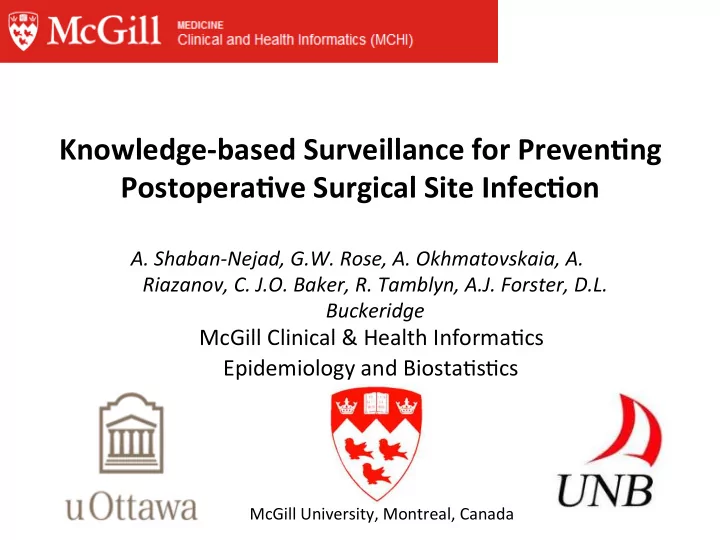

Knowledge-‑based ¡Surveillance ¡for ¡Preven6ng ¡ Postopera6ve ¡Surgical ¡Site ¡Infec6on ¡ A. ¡Shaban-‑Nejad, ¡G.W. ¡Rose, ¡A. ¡Okhmatovskaia, ¡A. ¡ Riazanov, ¡C. ¡J.O. ¡Baker, ¡R. ¡Tamblyn, ¡A.J. ¡Forster, ¡D.L. ¡ Buckeridge ¡ McGill ¡Clinical ¡& ¡Health ¡Informa4cs ¡ Epidemiology ¡and ¡Biosta4s4cs ¡ McGill ¡University, ¡Montreal, ¡Canada ¡
Hospital ¡Acquired ¡Infec4on ¡(HAI) ¡ • Not ¡present ¡or ¡incuba4ng ¡prior ¡to ¡the ¡pa4ent ¡being ¡ admiFed ¡to ¡the ¡hospital, ¡but ¡occurred ¡within ¡48-‑72 ¡hours ¡ aMer ¡admiFance ¡to ¡the ¡hospital. ¡ ¡ • ~ ¡1 ¡in ¡20 ¡pa4ents ¡acquires ¡HAI ¡ ¡ ¡ ¡ ¡ ¡ ¡ • Result ¡in ¡substan4ally ¡increased ¡medical ¡costs ¡ ¡ ¡ ¡ ¡ ¡ ¡ ¡ ¡ ¡ 2 ¡
Goals ¡ ¡ • i) ¡Development ¡of ¡an ¡integrated ¡HAI ¡Ontology ¡ ¡ • ii) ¡Mapping ¡of ¡local ¡terminologies ¡onto ¡concepts ¡in ¡HAI ¡Ontology ¡ ¡ • iii) ¡Development ¡of ¡ontology-‑powered, ¡rule-‑based ¡and ¡sta4s4cal ¡ methods ¡for ¡case ¡detec4on ¡ ¡ • iv) ¡Evalua4on ¡of ¡accuracy ¡of ¡case ¡detec4on ¡methods ¡ ¡ • v) ¡Providing ¡uniform ¡seman4c ¡interface ¡to ¡the ¡data ¡via ¡querying ¡ and ¡browsing ¡ 3 ¡
Hospital ¡Acquired ¡Infec4on ¡-‑ ¡Knowledge ¡In-‑Use ¡ (HAIKU)Project ¡-‑ ¡Overview ¡ 4 ¡
Sites ¡of ¡HAIs ¡ • Urinary ¡Tract ¡ ¡ ¡40% ¡ • Surgical ¡Wound ¡ ¡25% ¡ • Respiratory ¡Tract ¡ ¡20% ¡ • Bacteremia ¡ ¡ ¡3% ¡ • Others ¡ ¡ ¡12% ¡ Source: ¡D. ¡Syndman ¡(2004) ¡Nosocomial ¡or ¡Iatrogenic ¡InfecPons. ¡ 5 ¡
SSI’s ¡& ¡SSI ¡Surveillance ¡ • Surgical ¡site ¡infec4ons ¡are ¡common, ¡increase ¡ poor ¡outcomes ¡& ¡costs ¡ • Surveillance ¡helps ¡to ¡prevent ¡SSI ¡ ¡ – Enumerate, ¡report, ¡analyze ¡SSI ¡cases ¡ – Review ¡of ¡clinical ¡info ¡to ¡confirm ¡SSI ¡status ¡ • Labour-‑intensive ¡ • Surveillance ¡can ¡be ¡focused ¡on ¡high-‑probability ¡ pa4ents ¡by ¡using ¡clinical ¡data ¡to ¡“trigger” ¡review ¡ Source: ¡ ¡Greg ¡W. ¡Rose ¡ 6 ¡
SSI ¡Classifica4on ¡ Source: ¡CDC ¡Guideline ¡ 7 ¡
“Trigger ¡Factors” ¡for ¡SSI ¡Surveillance ¡ Surgery ¡ Risk ¡Factors ¡ ¡ ¡ ¡ ¡ ¡e.g. ¡obesity ¡ ¡ ¡ ¡ ¡ ¡ ¡ ¡ ¡ ¡ ¡ ¡ ¡ ¡female ¡gender ¡ ¡ ¡ ¡ ¡ ¡ ¡ ¡ ¡ ¡ ¡ ¡ ¡ ¡diabetes ¡mellitus ¡ ¡ Onset ¡of ¡SSI ¡ Iden4fica4on ¡Factors ¡ ¡ ¡ ¡ ¡ ¡e.g. ¡readmission ¡ ¡ ¡ ¡ ¡ ¡ ¡ ¡ ¡ ¡ ¡ ¡ ¡ ¡microbiology ¡ ¡ ¡ ¡ ¡ ¡ ¡ ¡ ¡ ¡ ¡ ¡ ¡ ¡an4bio4c ¡use ¡ ¡ Diagnosis ¡& ¡ Management ¡ Source: ¡ ¡Greg ¡W. ¡Rose ¡ 8 ¡
OFawa ¡Hospital ¡Data ¡Warehouse ¡ • Rela4onal ¡database ¡ – Contains ¡pharmacy, ¡radiology, ¡dicta4ons, ¡ administra4ve ¡data ¡ – Linked ¡by ¡common ¡iden4fier ¡keys ¡ – Enables ¡complex ¡modeling ¡using ¡integrated ¡health ¡ care ¡data ¡ – This ¡knowledge ¡can ¡be ¡used ¡for ¡IT-‑supported ¡work ¡ flow ¡transforma4on ¡ ¡ Source: ¡ ¡Greg ¡W. ¡Rose ¡ 9 ¡
OHDW ¡Map ¡ 10 ¡
Controlled ¡Vocabularies ¡ HAI ¡Ontology ¡ 11 ¡
HAI ¡Ontology ¡Top ¡Concepts ¡ 12 ¡ Partial view of the major components of the HAI ontology for surveillance of SSIs
13 ¡
Applica4on ¡Scenarios ¡ 14 ¡
Sample ¡Queries ¡ (I) • What are the common patient-associated risk factors for both SSIs and CAUTIs? • What effect has installation of new alcohol hand gel dispensers had on the Serratia SSI incidence in Cardiac Surgery Intensive Care Unit (CSICU)? • Are patients with SSI at risk of developing severe sepsis? • How many SSIs have been associated with our new brand of implantable ventricular assist device (VAD)? (II) • What potentially discontinuable medications are associated with development of SSI? • Is there an interaction between hypoxia (decreased oxygen supply) and hypoalbuminemia (reduced serum albumin concentration) in the development of SSI? (III) • What combination of laboratory and radiographic findings best identifies cases of prosthetic hip infections following hip replacement surgery? • Given that C-reactive protein elevation is sensitive and specific in patients with HAIs, what other potential acute phase reactants may be used for diagnosis? • What effect does the use of drugs with anti-inflammatory side effects have on the sensitivity of CT (computed tomography) findings of post-operatic abscess formation? 15 ¡
Acknowledgements ¡ ¡ ¡ ¡HAIKU ¡is ¡funded ¡by ¡the ¡Canadian ¡Ins4tutes ¡of ¡ Health ¡Research ¡(CIHR) ¡and ¡the ¡Natural ¡Sciences ¡ & ¡Engineering ¡Council ¡of ¡Canada ¡(NSERC). ¡ 16 ¡
Thank ¡You! ¡ 17 ¡
Recommend
More recommend